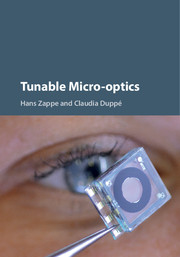Book contents
- Frontmatter
- Dedication
- Contents
- List of contributors
- List of acronyms
- Part I Introduction
- Part II Devices and materials
- Part III Systems and Applications
- 11 Characterization of Micro-optics
- 12 Photonic Crystals
- 13 MEMS Scanners for OCT Applications
- 14 Liquid Crystal Elastomer Micro-optics
- 15 Adaptive Scanning Micro-eye
- 16 Hyperspectral Eye
- 17 Plenoptic Cameras
- Index
- References
14 - Liquid Crystal Elastomer Micro-optics
from Part III - Systems and Applications
Published online by Cambridge University Press: 05 December 2015
- Frontmatter
- Dedication
- Contents
- List of contributors
- List of acronyms
- Part I Introduction
- Part II Devices and materials
- Part III Systems and Applications
- 11 Characterization of Micro-optics
- 12 Photonic Crystals
- 13 MEMS Scanners for OCT Applications
- 14 Liquid Crystal Elastomer Micro-optics
- 15 Adaptive Scanning Micro-eye
- 16 Hyperspectral Eye
- 17 Plenoptic Cameras
- Index
- References
Summary
Introduction
As delineated in Chapter 2, many optical systems in nature are based on soft and pliable organic tissue. Technical implementations of tunable optical systems, as described in Chapters 1, 3, 6, and 7, also benefit from the use of soft matter in the fabrication of optical components.
Whereas in natural optical systems such as the human eye, actuation (for tuning the focal length) uses flexible muscle tissue, most technical optical systems are actuated with rigid metallic or crystalline semiconductor-based actuators, that are used to deform a pliable optical component. Now, a new family of materials, liquid crystal elastomers (LCEs), represent a useful and novel means for generating force and movement in a micromechanical system and may thus be used to tune an optical system. In this chapter, we show how LCE-based actuators may be conceived to realize compact tunable irises and tunable lenses, all fabricated with soft materials.
The LCE is a polymer-based material that contracts and elongates significantly in direct dependence of temperature changes; it may thus be considered a thermal actuator characterized by a long stroke and able to generate significant force. By microstructuring the LCE and incorporating microfabricated heaters into the material, very compact actuators may be designed, allowing the realization of self-contained, highly miniaturized tunable optical systems.
Bioinspired tunable optical components have been demonstrated before. In the example shown in Figure 14.1a, Carpi et al. (2011) uses a dielectric elastomer to tune a pliable lens, thus imitating the human eye. Alternatively, liquids can be used to realize a completely fluidic tunable iris (Müller et al. 2012), which can be seen in Figure 14.1b; this system is discussed in-depth in Chapter 6.
Following the design of the human eye in both optics and actuation (Schuhladen et al. 2013), one challenge remained: the integration of individual components into a complete imaging system. In the following, we describe means for realizing actuation of soft-matter tunable optical devices using LCEs and the integration of these into an imaging system that includes a tunable lens and variable iris.We begin with an in-depth exposé of the chemistry, fabrication technology, and operating characteristics of LCEs. We then continue to characterize two optical components that rely on the characteristic behavior of this active material: an LCE-based iris and an LCE-actuated tunable lens. The chapter concludes with a discussion of the functionality of a complete imaging system that employs these components.
- Type
- Chapter
- Information
- Tunable Micro-optics , pp. 346 - 368Publisher: Cambridge University PressPrint publication year: 2015

